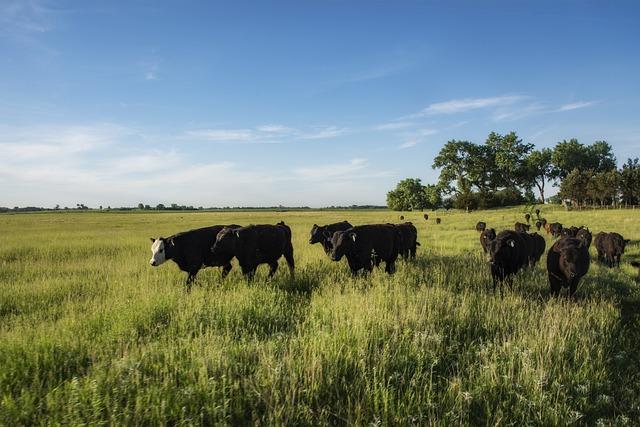In the sprawling landscapes where cattle graze under the vast, open skies, a quiet culinary debate simmers—a debate that reaches far beyond the pastures and into the heart of our kitchens and dinner plates. As consumers become increasingly conscious of their dietary choices, the distinction between grass-fed and grain-fed beef has emerged as a focal point of discussion. Each type of beef carries its own narrative, shaped by the environments and practices that bring it from pasture to plate. But as we stand at the crossroads of tradition and modernity, the question lingers: what truly defines the healthiness of our beef? Join us as we delve into the nuanced world of grass-fed versus grain-fed beef, unraveling the complexities and exploring the health implications that lie within each bite.
Nutritional Breakdown Exploring the Health Benefits and Drawbacks
In the debate between grass-fed and grain-fed beef, the nutritional content is a pivotal point of consideration. Grass-fed beef is often praised for its higher concentration of omega-3 fatty acids, which are essential for heart health. It also boasts elevated levels of antioxidants like vitamin E, known for its role in supporting the immune system. Furthermore, grass-fed beef typically contains less total fat, which can be appealing for those monitoring their calorie intake. Conversely, grain-fed beef tends to have a richer taste and is often more tender, thanks to the higher levels of intramuscular fat.
- Omega-3 Fatty Acids: Higher in grass-fed beef, beneficial for heart health.
- Vitamin E: More abundant in grass-fed options, supports the immune system.
- Fat Content: Grain-fed beef generally has more marbling, leading to a richer flavor.
However, it’s important to note that grain-fed beef is not without its merits. It typically provides a higher concentration of omega-6 fatty acids, which play a crucial role in brain function and growth. While these differences are noteworthy, the choice between grass-fed and grain-fed often comes down to personal preference and dietary priorities. Whether you prioritize the leaner profile of grass-fed or the flavorful richness of grain-fed, each type offers unique benefits and potential drawbacks.

Environmental Impact How Feeding Practices Shape Our Planet
The feeding practices adopted in beef production have profound implications for our environment. Grass-fed beef is often touted as the more sustainable option due to its natural alignment with ecosystems. Cattle raised on pastures contribute to biodiversity, help sequester carbon in the soil, and maintain healthier soil systems. This method also reduces the need for synthetic fertilizers and pesticides. However, it requires more land and time, which can lead to deforestation if not managed responsibly.
On the other hand, grain-fed beef is typically associated with more intensive farming practices. This approach often leads to increased greenhouse gas emissions due to the energy-intensive production of grains and the use of confined animal feeding operations (CAFOs). Moreover, it can lead to significant water consumption and pollution. Yet, grain-fed systems can yield more beef in a shorter period and require less land compared to grass-fed systems. Here are some key environmental considerations:
- Land Use: Grass-fed requires more space, potentially leading to habitat conversion.
- Carbon Footprint: Grain-fed systems typically have higher emissions due to feed production.
- Water Usage: Grain production for feed can be water-intensive.
- Biodiversity: Grass-fed systems can support more wildlife if managed sustainably.

Taste and Texture What Your Palate Needs to Know
When it comes to the sensory experience of beef, the differences between grass-fed and grain-fed varieties are subtle yet significant. Grass-fed beef often carries a more complex, earthy flavor profile, with a hint of nuttiness. This is due to the natural diet of grasses, herbs, and other plants. On the other hand, grain-fed beef, often corn or soy-based, tends to be sweeter and richer, offering a buttery texture that melts in your mouth.
- Grass-Fed: Known for a leaner texture, resulting in a firmer bite.
- Grain-Fed: Usually more marbled, providing a juicier and more tender experience.
For those who appreciate a robust, slightly gamier taste, grass-fed beef is a culinary adventure worth pursuing. Meanwhile, the grain-fed counterpart offers a classic, familiar savor that many have come to love. Ultimately, your choice will depend on your palate’s preference for either the nuanced complexities of grass-fed or the indulgent richness of grain-fed beef.

Making the Choice Personal Health Goals and Ethical Considerations
When deciding between grass-fed and grain-fed beef, personal health goals and ethical considerations play a crucial role. Health-conscious individuals often prioritize nutritional benefits, looking at factors such as omega-3 fatty acids, antioxidants, and overall fat content. Grass-fed beef is frequently highlighted for its higher omega-3 levels and CLA (conjugated linoleic acid), which are believed to support heart health and reduce inflammation.
On the other hand, ethical considerations can heavily influence consumer choices. Some people focus on the welfare of the animals and the environmental impact of their diet. Grass-fed cattle typically roam free, which aligns with the values of those advocating for humane animal treatment and sustainable farming practices. Considerations include:
- Animal welfare and living conditions
- Environmental impact of farming practices
- Support for local and sustainable agriculture
Ultimately, the choice between grass-fed and grain-fed beef may come down to balancing these health and ethical priorities, making it a deeply personal decision.
Concluding Remarks
As we conclude our exploration into the world of grass-fed and grain-fed beef, it’s clear that the choice is not just a matter of health, but a tapestry woven with threads of personal preference, ethical considerations, and environmental impact. Each option presents its own set of benefits and challenges, leaving the ultimate decision in the hands of informed consumers who are now armed with the knowledge to make choices that align with their values and dietary needs. Whether your palate favors the robust flavors of grass-fed beef or the marbled tenderness of grain-fed, the journey of understanding enriches the experience of every bite. As the debate continues to evolve, so too will our understanding, ensuring that the dialogue remains as dynamic and layered as the very flavors we savor.




